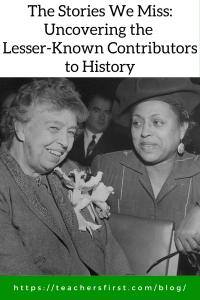Although teaching significant historical events is important, we sometimes overlook opportunities to recognize those who contribute to the story in lesser-known ways. Integrating these underrecognized persons into lessons offers opportunities for deeper learning and understanding of world events while increasing student engagement. In addition, learning about the lesser-known stories in history enables students to explore information by looking at events from various viewpoints and perspectives.
Consider Eleanor Roosevelt, a name many students are familiar with due to her role as First Lady. However, her influence goes well beyond this title; she redefined the role of the First Lady through her active involvement in politics and her advocacy for human rights. During her husband’s presidency, she was a vocal supporter of civil rights, racial equality, workers’ rights, women’s rights, and more. Her regular radio broadcasts and press conferences made her a household name, and her impact on society was profound.
Many Americans overlook Eleanor Roosevelt’s profound contributions to society, viewing her primarily through the lens of her husband’s impactful presidency. While historians widely recognize Franklin D. Roosevelt for his New Deal policies and leadership during World War II, they frequently overlook Eleanor’s equally impactful work in shaping social policy and human rights in mainstream historical narratives. By sharing Eleanor’s story, students learn about complex political roles, the changing role of women in politics, and the grassroots efforts she laid as groundwork for future civil rights movements. Exploring such “hidden figures” in history challenges students to think critically about whose stories historians tell and why, fostering a more nuanced and inclusive approach to understanding our past.
Consider integrating short presentations using the Project Zero Thinking Routines Toolbox (reviewed here) to seamlessly incorporate information about underrecognized historical figures as a lesson extension to your current curriculum.
- You can start by using AI chatbots such as Claude (reviewed here) or Perplexity (reviewed here) to find names of significant but lesser-known historical figures to include in your current lessons. An example prompt might be, “I am teaching about World War 2 to my 7th-grade students. Share a list of some underrepresented historical figures from this period to include with my lessons.”
- Take advantage of the features of Gamma (reviewed here), an AI presentation tool creator, to generate a slide presentation, website, or document to share information about the historical figure with students. Begin with a simple prompt describing the period, historical event, or person to study. Edit and add information as needed before sharing it with students. Always check the information created with AI tools to ensure accuracy. Here is an example of a Gamma presentation created with the prompt, “Eleanor Roosevelt as an underrated historical figure.”
- Use the Project Zero Thinking Routine, Think Puzzle Explore, to ask students to analyze and consider this person’s contributions to history and why they might not be as well-known as others.
- Think: What do students already know about lesser-known historical figures and why they might be overlooked?
- Puzzle: What questions do students have about the person’s significance and why they are less well-known?
- Explore: How can students investigate the reasons behind the person’s lack of recognition?
Exploring the stories of underrecognized historical figures enriches our understanding of the past and helps develop critical thinking skills by encouraging students to question established narratives and seek out lesser-known voices. It provides a more nuanced view of history that helps to build empathy and curiosity.
Do you have a favorite lesson or activity introducing lesser-known historical figures to provide context and interest in historical events? Share your ideas in the comments below as we learn together.


